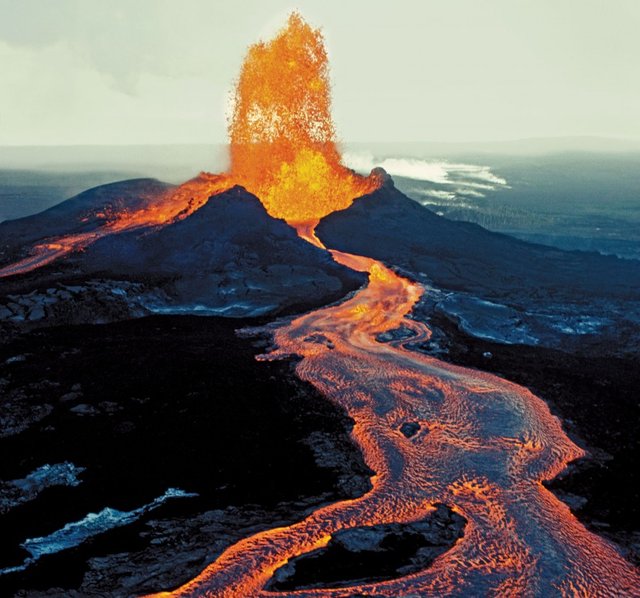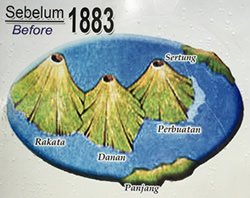Mount Krakatau Ancient

Krakatau (English: Krakatoa) is an active volcanic archipelago located in the Sunda Strait between the islands of Java and Sumatra belonging to the reserve area. This name was once pinned on the top of a volcano there (Mount Krakatau) that vanished because of its own eruption on 26-27 August 1883. The eruption was very powerful; the resulting heat cloud and tsunami killed around 36,000 people. Until December 26, 2004, this tsunami was the largest in the Indian Ocean region. The sound of the eruption was heard up in Alice Springs, Australia and Rodrigues Island near Africa, 4653 kilometers. Its explosive power is estimated at 30,000 times the atomic bomb that was detonated in Hiroshima and Nagasaki at the end of World War II.
Sunda Strait
The eruption of Krakatau causes global climate change. The world was dark for two and a half days due to the volcanic ash that covered the atmosphere. The sun shines dim until next year. Scattering of dust is visible in Norwegian sky to New York.
Krakatau explosion is actually still less than the eruption of Mount Toba and Mount Tambora in Indonesia, Mount Tanpo in New Zealand and Mount Katmal in Alaska. However, these mountains erupted deep in times when the human population was still very small. As Krakatoa erupts, human populations are already densely packed, science and technology have developed, telegraphs have been discovered, and submarine cables have been installed. Thus it can be said that at that time information technology is growing and growing rapidly.
It is noted that the eruption of Mount Krakatau was the first major catastrophe in the world after the invention of the undersea telegraph. The progress, unfortunately has not been matched by progress in the field of geology. The geologists were not even able to explain the eruption. Krakatau volcano erupts, the vibrations felt to Europe
Seeing the area of Mount Krakatoa in the Sunda Strait, the experts estimate that in ancient times there was a very large mountain in the Sunda Strait which eventually erupted violently leaving a caldera (large crater) called Krakatau Ancient Mountain, which is the parent of Krakatoa volcano erupting at 1883. The mountain is composed of andesitic stones.
Notes on the eruption of Ancient Krakatau taken from an Old Javanese text called King Parwa Reader which dates from 416 AD. The contents among others stated:
"There is a thunderous voice coming from Mount Batuwara. There are also terrifying earth shocks, total darkness, lightning and lightning. Then came windstorms and terrible rain and the whole storm darkened the whole world. A great flood came from Batuwara Mountain and flowed eastward to Mount Kamula .... When the water drowned, the island of Java was split into two, creating the island of Sumatra "
Krakatoa evolution map-fr.gif
Geologist Berend George Escher and some other experts argue that the natural occurrences told came from the ancient Mount Krakatoa, which in the text called Mount Batuwara. According to the book of King Parwa Reader, the height of this Ancient Krakatau reaches 2,000 meters above sea level, and its coastal circle reaches 11 kilometers.
As a result of this great explosion, three quarters of the body of Krakatau Purba destroyed leaving the caldera (large crater) in the Sunda Strait. The sides or rim of the crater are known as Rakata Island, Pulau Panjang and Pulau Sertung, in another note referred to as Rakata Island, Rakata Kecil Island and Sertung Island. The eruption of this mountain is allegedly responsible for the occurrence of the dark ages on earth. The bubonic disease occurs because the temperature cools. This sample significantly reduces the number of people on earth.
This eruption is also considered to contribute to the end of the Persian primeval heyday, the transmutation of the Roman Empire to the Byzantine Empire, the end of South Arabia civilization, the extinction of the Mayan city of Tikal and the enigmatic fall of Nazca civilization in South America. Ancient Krakatoa explosion is estimated to last for 10 days with an estimated mass velocity of up to 1 million tons per second. The explosion has formed a 20-150 meter atmospheric shield, lowering temperatures by 5-10 degrees over 10-20 years.
The rise of Mount Krakatoa [edit | edit source]
The Development of Krakatau Mountain
Rakata Island, which is one of the three remaining islands of Mount Krakatau Purba then grows in accordance with the volcanic impulse from the bowels of the earth known as Mount Krakatau (or Gunung Rakata) made of basaltic rock. Then, two volcanoes emerged from the center of the crater, named Mount Danan and Mount Perbuwatan which then merged with Mount Rakata which appeared first. The unity of these three volcanoes is called Mount Krakatoa.
Krakatau volcano erupted in 1680 producing acid andesitic lava. Then in 1880, Mount Perbuwatan actively removed lava even though it did not erupt. After that time, there was no volcanic activity in Krakatoa until May 20, 1883. On that day, after 200 years of sleep, there was a small explosion on Mount Krakatau. That is the first signs of a major eruption in the Sunda Strait. This small explosion was then followed by small eruptions that peak occurred on 26-27 August 1883.
Error 1883 [edit | edit source]
Main article for this section are: Krakatau eruption 1883
On Monday, August 27, 1883, exactly at 10.20, there was an explosion on the mountain. According to Simon Winchester, a geologist who graduated from Oxford University of England who is also the author of National Geographic said that the explosion was the largest, the loudest sound and the most destructive volcanic events in the history of modern humans. The sound of the eruption was heard up to 4,600 km from the center of the eruption and could even be heard by 1/8 of the inhabitants of the earth at that time.
According to researchers at the University of North Dakota, the explosion of Krakatoa along with the Tambora explosion (1815) recorded the greatest Volcanic Explosivity Index (VEI) value in modern history. The Guinness Book of Records records the explosion of Krakatau as the most powerful explosion recorded in history.
The Krakatau explosion has thrown volcanic rocks and volcanic ash with a volume of 18 cubic kilometers. Burst of volcanic dust reaches 80 km. Hard objects that spilled into the air fell on the plains of the island of Java and Sumatra even to Sri Lanka, India, Pakistan, Australia and New Zealand.
The eruption destroyed Mount Danan, Mount Perbuwatan and part of Mount Rakata where half of its cones disappeared, making the basin as wide as 7 km and 250 meters deep. Tsunami (ocean waves) rise as high as 40 meters destroy villages and anything that is on the coast.